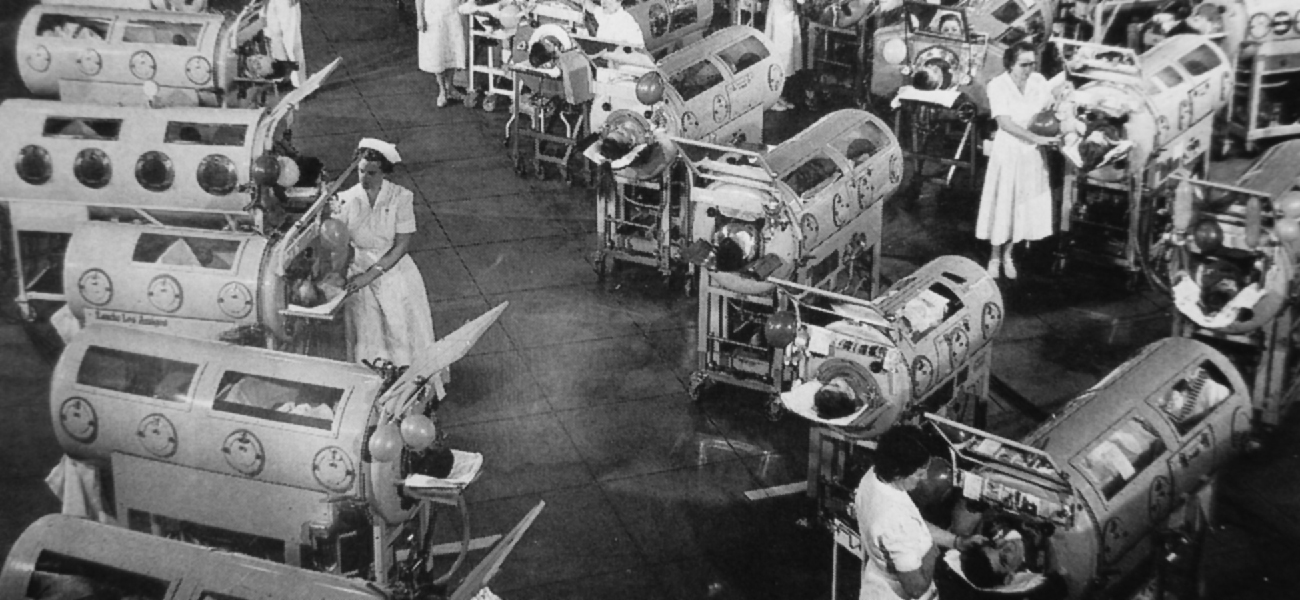18: Specific Adaptive Host Defenses
- Page ID
- 5220
People living in developed nations and born in the 1960s or later may have difficulty understanding the once heavy burden of devastating infectious diseases. For example, smallpox, a deadly viral disease, once destroyed entire civilizations but has since been eradicated. Thanks to the vaccination efforts by multiple groups, including the World Health Organization, Rotary International, and the United Nations Children’s Fund (UNICEF), smallpox has not been diagnosed in a patient since 1977. Polio is another excellent example. This crippling viral disease paralyzed patients, who were often kept alive in “iron lung wards” as recently as the 1950s (Figure \(\PageIndex{1}\)). Today, vaccination against polio has nearly eradicated the disease. Vaccines have also reduced the prevalence of once-common infectious diseases such as chickenpox, German measles, measles, mumps, and whooping cough. The success of these and other vaccines is due to the very specific and adaptive host defenses that are the focus of this chapter.
Innate Nonspecific Host Defenses described innate immunity against microbial pathogens. Higher animals, such as humans, also possess an adaptive immune defense, which is highly specific for individual microbial pathogens. This specific adaptive immunity is acquired through active infection or vaccination and serves as an important defense against pathogens that evade the defenses of innate immunity.

- 18.1: Architecture of the Immune System
- Adaptive immunity is defined by two important characteristics: specificity and memory. Specificity refers to the adaptive immune system’s ability to target specific pathogens, and memory refers to its ability to quickly respond to pathogens to which it has previously been exposed. For example, when an individual recovers from chickenpox, the body develops a memory of the infection that will specifically protect it from the causative agent if it is exposed to the virus again later.
- 18.2: Antigens, Antigen Presenting Cells, and Major Histocompatibility Complexes
- Major histocompatibility complex (MHC) molecules are expressed on the surface of healthy cells, identifying them as normal and “self” to natural killer (NK) cells. MHC molecules also play an important role in the presentation of foreign antigens, which is a critical step in the activation of T cells and thus an important mechanism of the adaptive immune system.
- 18.3: T Lymphocytes
- The antibodies involved in humoral immunity often bind pathogens and toxins before they can attach to and invade host cells. Thus, humoral immunity is primarily concerned with fighting pathogens in extracellular spaces. However, pathogens that have already gained entry to host cells are largely protected from the humoral antibody-mediated defenses. Cellular immunity, on the other hand, targets and eliminates intracellular pathogens through the actions of T lymphocytes, or T cells.
- 18.4: B Lymphocytes and Antibodies
- Humoral immunity refers to mechanisms of the adaptive immune defenses that are mediated by antibodies secreted by B lymphocytes, or B cells. This section will focus on B cells and discuss their production and maturation, receptors, and mechanisms of activation.
- 18.5: Vaccines
- By artificially stimulating the adaptive immune defenses, a vaccine triggers memory cell production similar to that which would occur during a primary response. In so doing, the patient is able to mount a strong secondary response upon exposure to the pathogen—but without having to first suffer through an initial infection. In this section, we will explore several different kinds of artificial immunity along with various types of vaccines and their mechanisms for inducing artificial immunity.
Thumbnail: From left to right: erythrocyte, platelet and lymphocyte. (Public Domain; The National Cancer Institute at Frederick).


